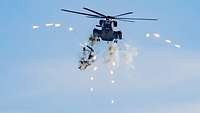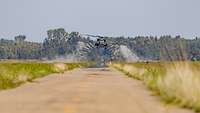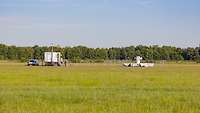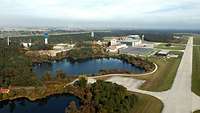Flares in the air: False targets for helicopters tested
Flares in the air: False targets for helicopters tested
- Date:
- Place:
- Manching
- Reading time:
- 2 MIN
Aircraft self-protection is of the highest priority. That is why a team from the Bundeswehr Technical Center for Aircraft and Aeronautical Equipment (WTDWehrtechnische Dienststelle 61) in Manching in Bavaria tested modified decoys for helicopters in early September. They received support from other Bundeswehr agencies.
Decoys for deception
In an emergency, so-called decoys are used as false targets to divert incoming guided weapons from their original target, thereby protecting it. Flares and chaffs are two of these decoys.
Flares – for instance hot-burning magnesium flares – are pyrotechnical decoys and are used to defend against guided missiles with an infrared (IRInfrarot) seeker. Their aim: Their IRInfrarot radiation is intended to simulate or mask the hot engine exhaust gas.
Chaffs, on the other hand, – a term derived from agriculture – are ejected against guided missiles with a radar seeker. They often consist of coated glass fibers which jam radar waves.
A combination of two tests
WTDWehrtechnische Dienststelle 61‘s trials above the technical center’s Feilenmoos test site combined two testing tasks. On the one hand, false targets were tested with a view to their compatibility with aircraft. On the other hand, so-called ‟area flares” were tested. These are flares with a pyrophoric – Greek for “fire-bearing” – pyrotechnic component producing a bigger deception area than standard flares which have a more local effect. Even small amounts of pyrophoric agents ignite spontaneously when in contact with the oxygen in the air and produce a hot IRInfrarot signature. This signature will then be identified by an IRInfrarot sensor as an object.
64 Helicopter Wing from Laupheim Air Base in Upper Swabia provided a CH‑53, a medium transport helicopter. The aim of the trials was to get a permanent certificate for modified and pyrophoric false targets for helicopters. To achieve this, all parameters had to be recorded and documented with specific test measuring equipment.
Support from Meppen
At WTDWehrtechnische Dienststelle 61, the appropriate facility for trajectory measurement was already in use for another trial, so the Bundeswehr Technical Center for Weapons and Ammunition (WTDWehrtechnische Dienststelle 91) in Meppen sent a team to help out. They traveled to Feilenmoos with an MSPMultisensorplattform-2000 multi-sensor platform.
Both platforms were equipped with special IRInfrarot and visual cameras, high‑speed cameras among others, which were used to record video footage with several terabytes’ worth of data volume. This is now being evaluated in the framework of the certification procedure.






